
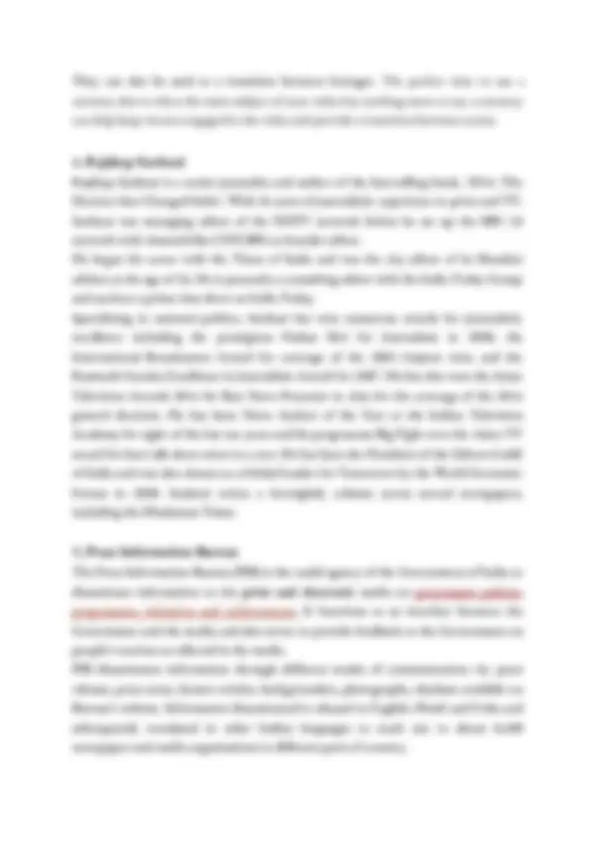
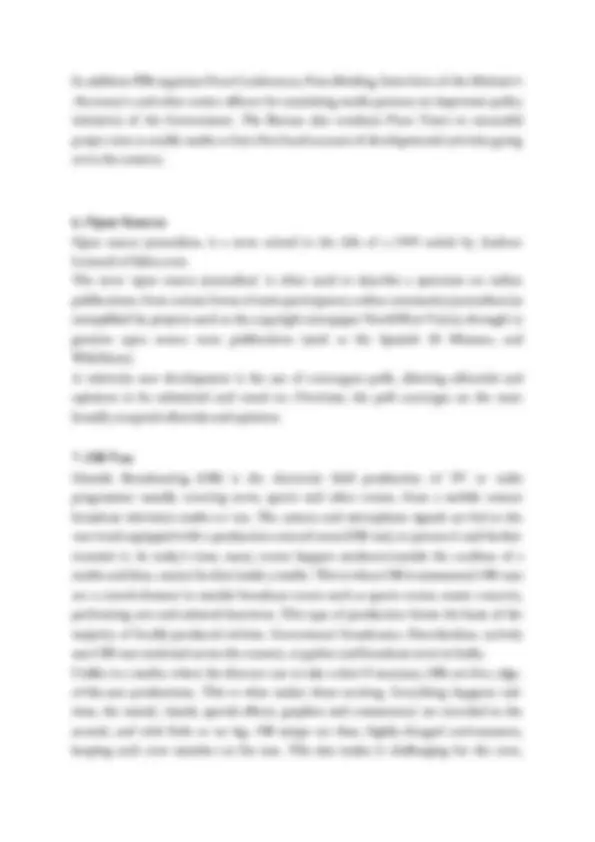
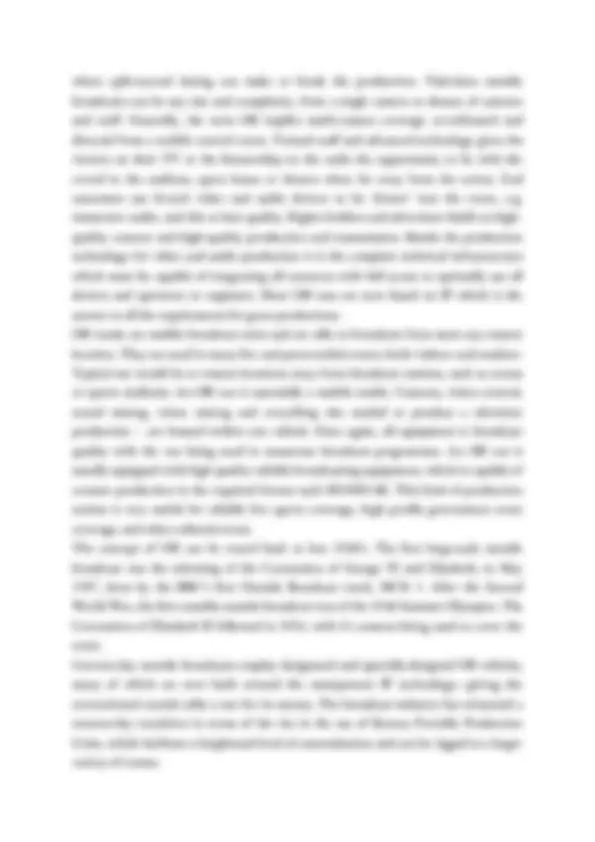
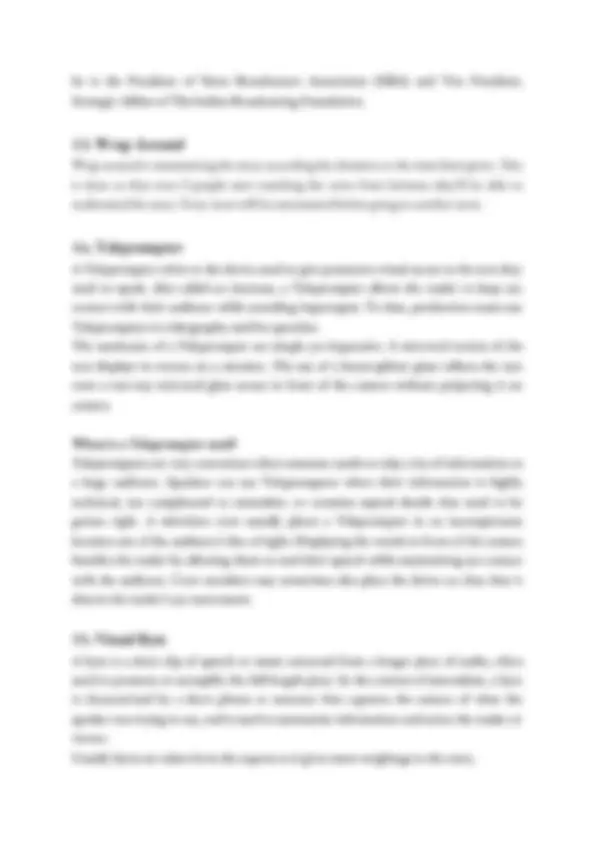
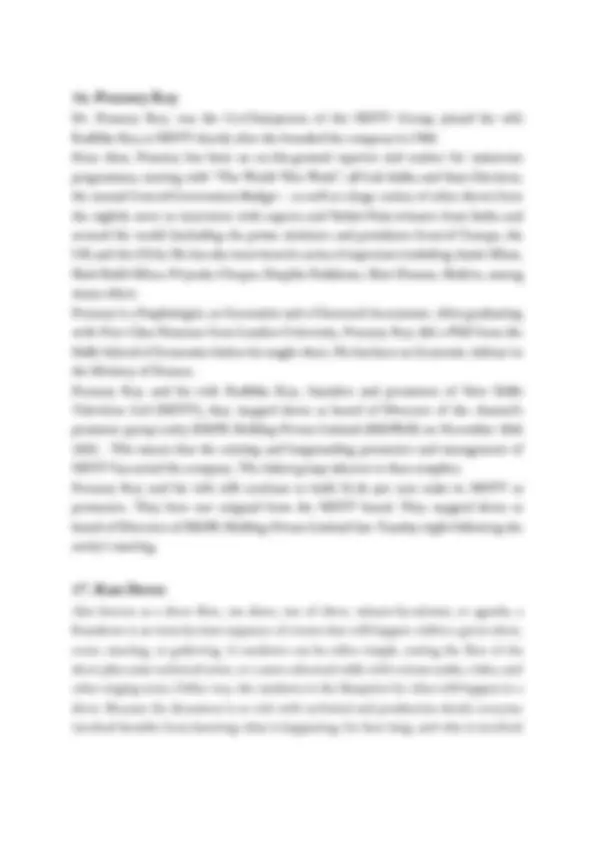
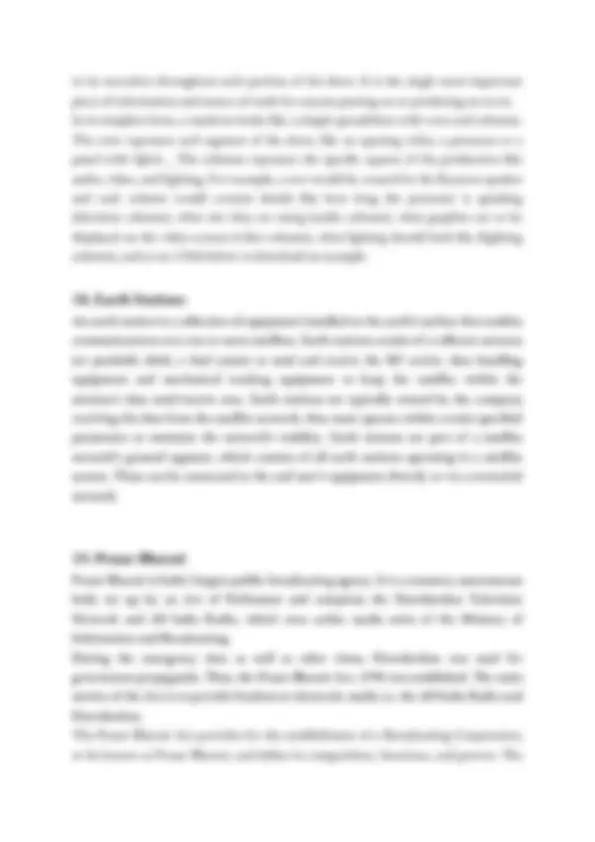
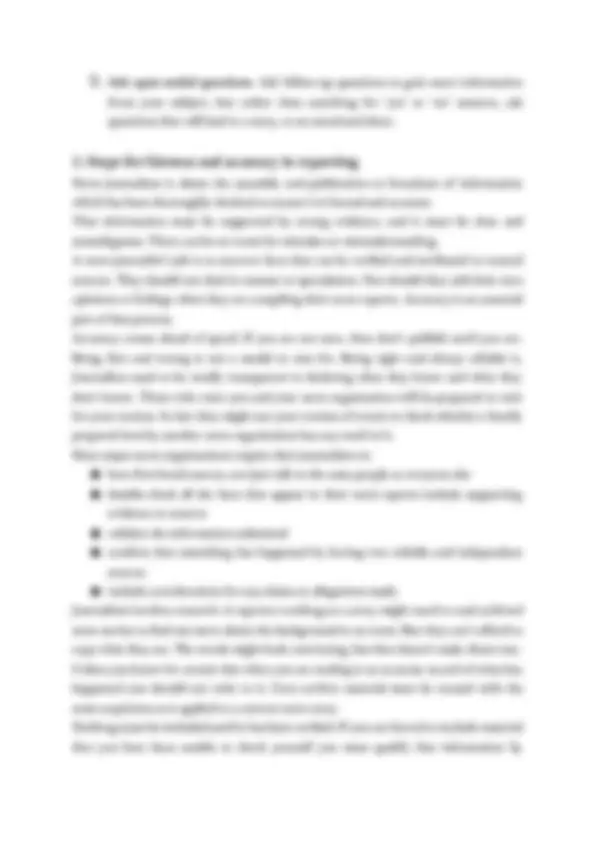
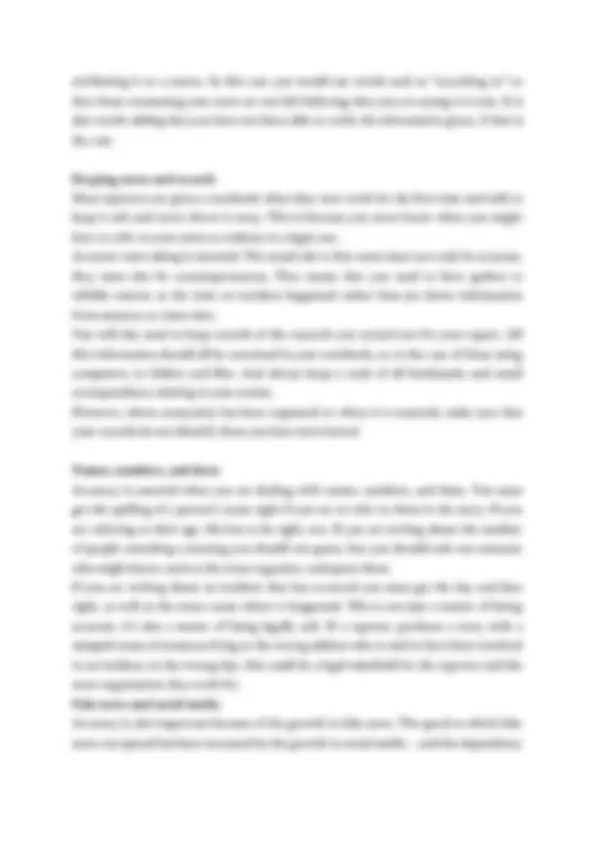
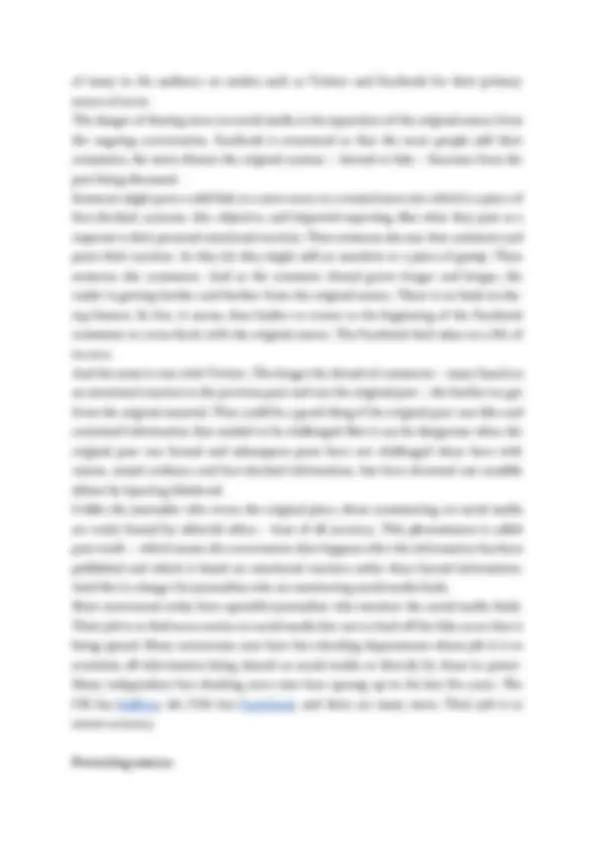
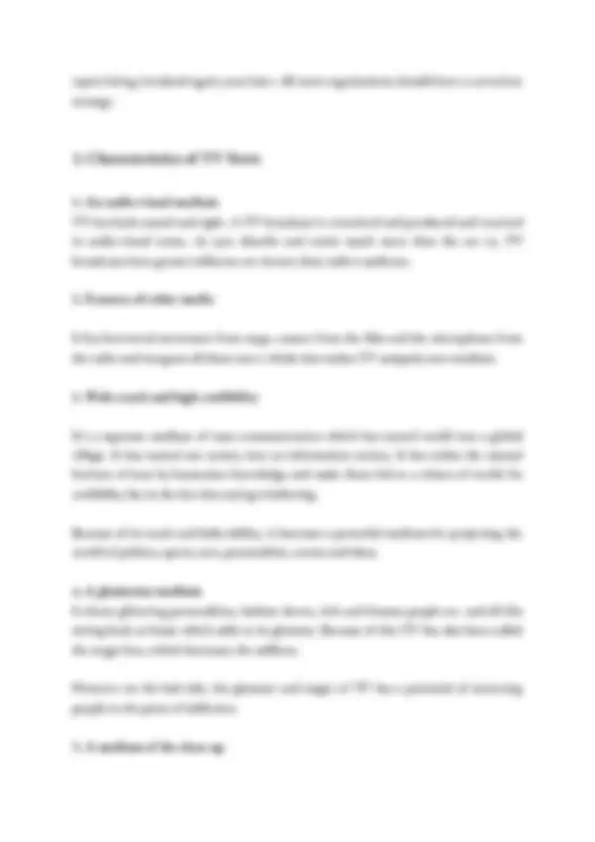
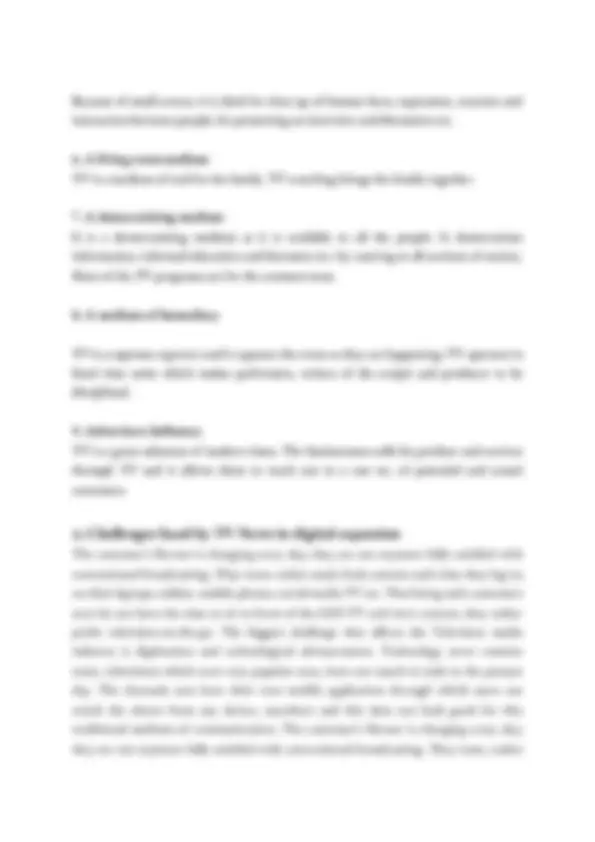
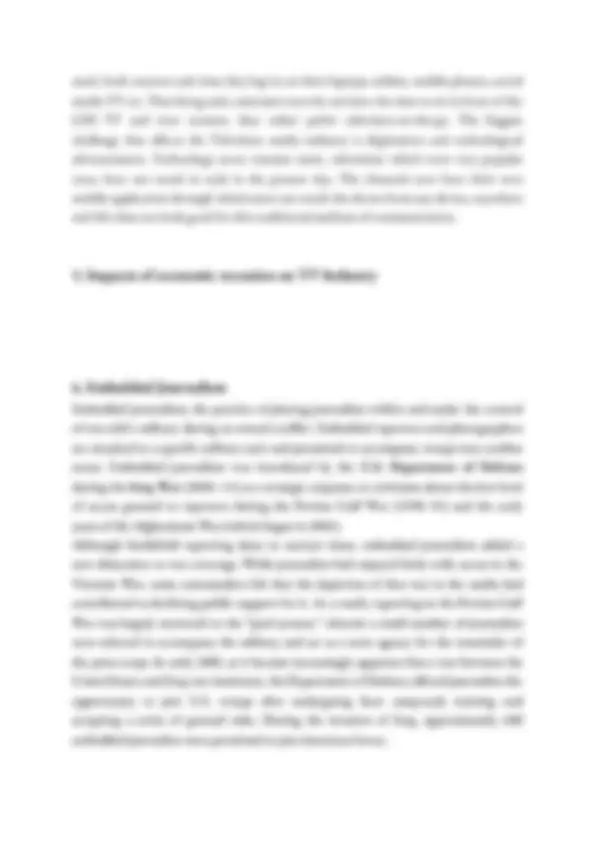
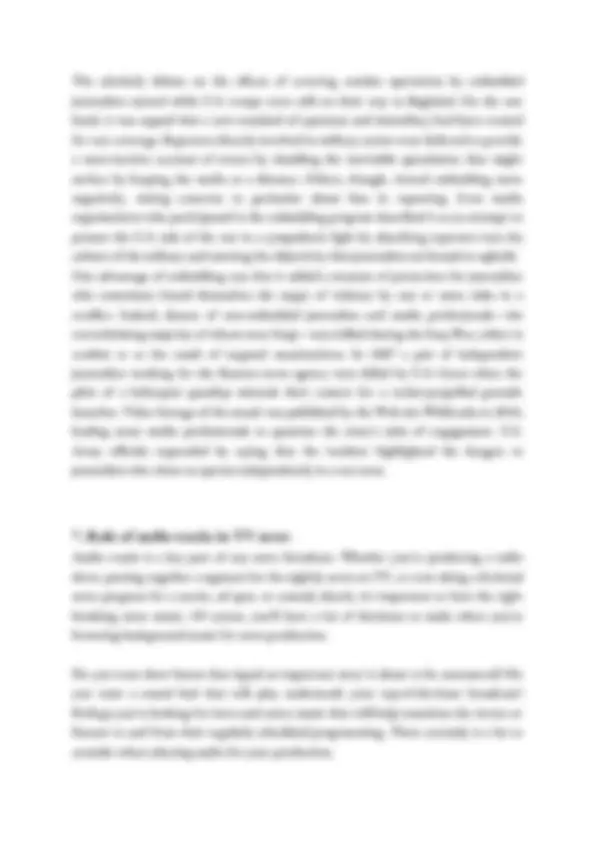
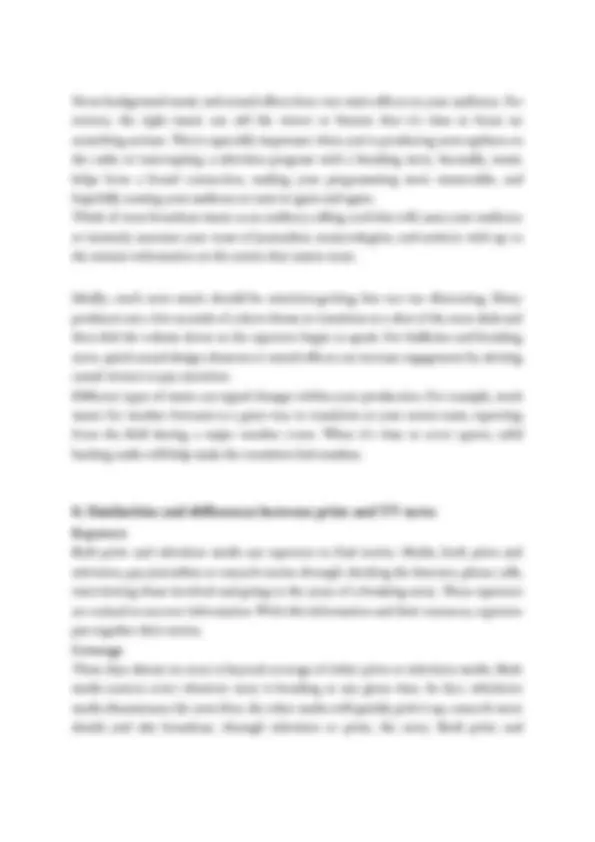
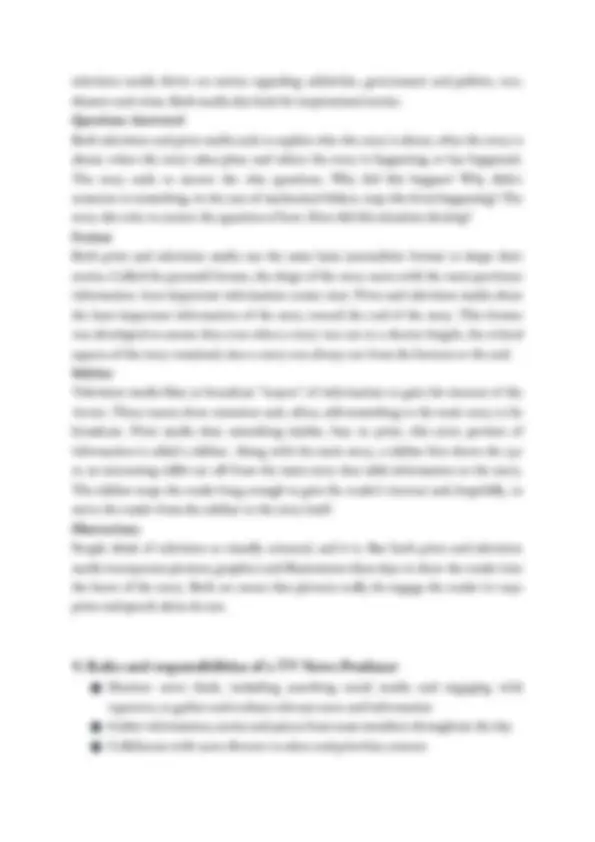
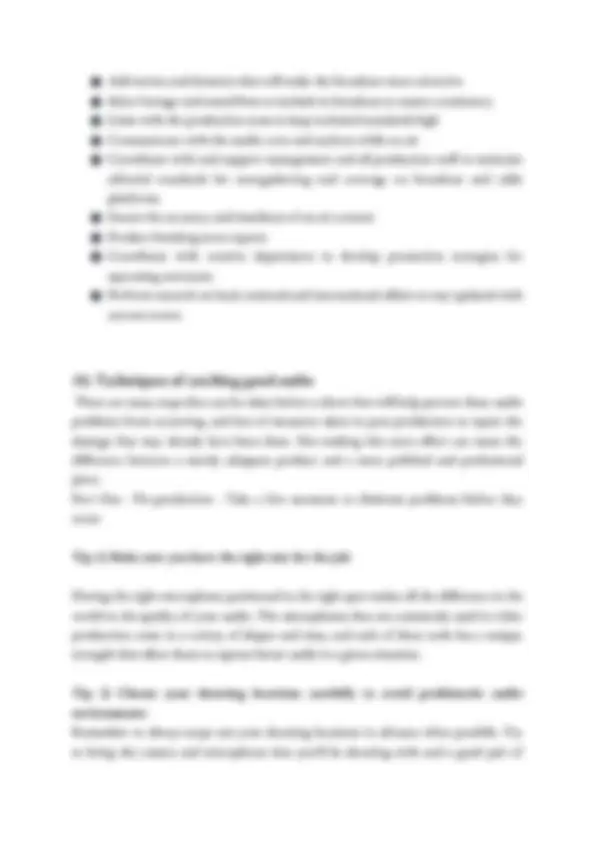
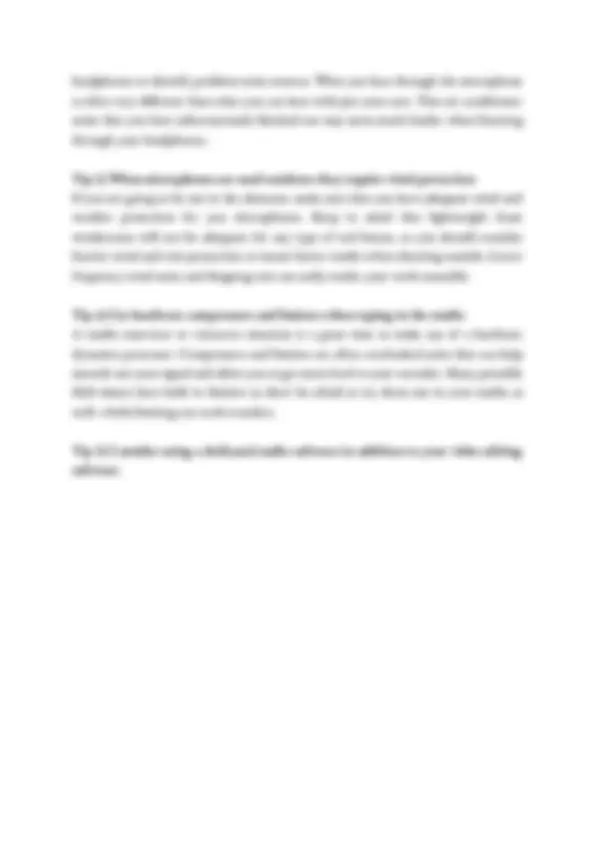


Study with the several resources on Docsity

Earn points by helping other students or get them with a premium plan


Prepare for your exams
Study with the several resources on Docsity

Earn points to download
Earn points by helping other students or get them with a premium plan
Community
Ask the community for help and clear up your study doubts
Discover the best universities in your country according to Docsity users
Free resources
Download our free guides on studying techniques, anxiety management strategies, and thesis advice from Docsity tutors
Electronic News Gathering, VFX, Cut Aways, OB Vans, Suhasini Haidar, Run Order, and INSAT. Electronic News Gathering refers to the art collection of words and pictures in the form of electric news. VFX is a term used to describe imagery created, manipulated, or enhanced for any film, or other moving media that doesn't take place during live-action shooting. Cutaway shots are a great way to show the audience what is happening elsewhere, or provide an alternate perspective. OB vans are mobile broadcast units and are able to broadcast from most any remote location. Suhasini Haidar is the Diplomatic Editor of The Hindu. Run Order is the order in which the parts of an event, meeting, etc. have been arranged to happen. INSAT is a series of multipurpose geostationary satellites launched by ISRO to satisfy the telecommunications, broadcasting, meteorology, and search and resc.
Typology: Quizzes
1 / 25

This page cannot be seen from the preview
Don't miss anything!


















Electronic News Gathering (ENG) refers to the art collection of words and pictures in the form of electric news. Coined in the 1970s when video recording was first utilized, electronic news gathering is commonly used in reporting. Since television was first introduced, news has been a very important aspect of programming. It allowed people to find out about newsworthy information as it was breaking instead of having to wait for it to be printed in a newspaper. It also allowed for audiences to see footage of events that were associated with news story. However, the issue with broadcasting news on TV was that the footage wasn’t accessible for several hours after something newsworthy took place. This means that washing breaking news on TV involved a reporter reading about the events. The flexible use of portable electronic equipment to record events and present them on a specific communication media. Electronic News Gathering commenced in 1970. Reporters gather events and instantly feed them to the channel studio for airing on TV. Electronic News Gathering has made it easier and quicker to transmit news to the target audience. The ENG process is used by reporters and editors and can involve a variety of modalities, including a single video camera to a complete news crew utilizing a truck on a location.
Visual effects (VFX) is a term used to describe imagery created, manipulated, or enhanced for any film, or other moving media that doesn't take place during live-action shooting. VFX often involves the integration between actual footage and this manipulated imagery to create realistic looking environments for the context. These environments created are either too dangerous to actually shoot, or worlds that just don’t exist. They use computer-generated imagery (CGI), and particular VFX software to make it happen. VFX producers communicate with directors and cinematographers to determine which scenes require them to shoot with green screens.
Visual effects are different from special effects because visual effects require a computer and are added in after shooting. Special effects, or SFX are realized on set — they are things like purposeful and controlled explosions, fake gunshot wounds, etc. In the news room the anchor will be seated infront of a green screen or blue screen later using "Chroma Keying" or Compositing is when artists combine visual effects from different origins to make it appear like they are in the same place. This involves using a green or blue screen which is later replaced with various elements using compositing example of this is using live footage with matte paintings- illustrated backgrounds or settings composited with live footage. COMMON VFX SOFTWARE:
A cutaway shot is a shot that "cuts away" from the main action to any shot that adds visual information, and then returns to the original shot with new meaning. Imagery shown in a cutaway can occur anywhere in relation to your scene, and have no strict geographical requirement. Shooting seamless cutaways isn’t always easy, so sometimes cutaways serve as a band aid for poor shooting, and often take place in the editing room. While cutaways are shots, it’s important to note that editors use them for maintaining continuity. Cutaways in news can also be used as a way of showing what is happening at different points in time or space. The best way to use this tool is to cut away when there is an action happening between two people who have been talking for a while, so we can see what they’re feeling about it as opposed to just hearing them talk about it. Cutaway shots are a great way to show the audience what is happening elsewhere, or provide an alternate perspective.
In addition PIB organizes Press Conferences, Press Briefing, Interviews of the Minister’s /Secretary’s and other senior officers for sensitizing media persons on important policy initiatives of the Government. The Bureau also conducts Press Tours to successful project sites to enable media to have first hand account of developmental activities going on in the country.
Open source journalism, is a term coined in the title of a 1999 article by Andrew Leonard of Salon.com. The term 'open source journalism' is often used to describe a spectrum on online publications: from various forms of semi-participatory online community journalism (as exemplified by projects such as the copyright newspaper NorthWest Voice), through to genuine open source news publications (such as the Spanish 20 Minutes, and WikiNews). A relatively new development is the use of convergent polls, allowing editorials and opinions to be submitted and voted on. Overtime, the poll converges on the most broadly accepted editorials and opinions.
Outside Broadcasting (OB) is the electronic field production of TV or radio programme: usually covering news, sports and other events, from a mobile remote broadcast television studio or van. The camera and microphone signals are fed to the van/truck equipped with a production control room (OB van), to process it and further transmit it. In today’s time, many events happen outdoors/outside the confines of a studio and thus, cannot be shot inside a studio. This is where OB is summoned. OB vans are a central element in outside broadcast events such as sports events, music concerts, performing arts and cultural functions. This type of production forms the basis of the majority of locally-produced airtime. Government broadcaster, Doordarshan, actively uses OB vans stationed across the country, to gather and broadcast news in India. Unlike in a studio, where the director can re-take a shot if necessary, OBs are live, edge- of-the-seat productions. This is what makes them exciting. Everything happens real- time, the sound, visuals, special effects, graphics and commentary are recorded to the second, and with little or no lag. OB setups are thus, highly-charged environments, keeping each crew member on his toes. This also makes it challenging for the crew,
where split-second timing can make or break the production. Television outside broadcasts can be any size and complexity, from a single camera to dozens of cameras and staff. Generally, the term OB implies multi-camera coverage co-ordinated and directed from a mobile control room. Trained staff and advanced technology gives the viewers on their TV or the listenership on the radio the opportunity to be with the crowd in the stadium, opera house or theatre when far away from the action. End customers use hi-tech video and audio devices to be ‘drawn’ into the event, e.g. immersive audio, and this at best quality. Rights holders and advertisers build on high- quality content and high-quality production and transmission. Beside the production technology for video and audio production it is the complete technical infrastructure which must be capable of integrating all resources with full access to optimally use all devices and operators or engineers. Most OB vans are now based on IP which is the answer to all the requirements for great productions. OB trucks are mobile broadcast units and are able to broadcast from most any remote location. They are used in many live and prerecorded events, both: indoor and outdoor. Typical use would be at remote locations away from broadcast stations, such as arenas or sports stadiums. An OB van is essentially a mobile studio. Cameras, vision control, sound mixing, vision mixing and everything else needed to produce a television production – are housed within one vehicle. Once again, all equipment is broadcast quality with the van being used in numerous broadcast programmes. An OB van is usually equipped with high quality reliable broadcasting equipment, which is capable of content production in the required format such SD/HD/4K. This kind of production station is very useful for reliable live sports coverage, high profile government event coverage, and other cultural events. The concept of OB can be traced back to late 1920’s. The first large-scale outside broadcast was the televising of the Coronation of George VI and Elizabeth, in May 1937, done by the BBC’s first Outside Broadcast truck, MCR 1. After the Second World War, the first notable outside broadcast was of the 1948 Summer Olympics. The Coronation of Elizabeth II followed in 1953, with 21 cameras being used to cover the event. Current-day outside broadcasts employ designated and specially-designed OB vehicles, many of which are now built around the omnipresent IP technology—giving the conventional coaxial cable a run for its money. The broadcast industry has witnessed a noteworthy transition in terms of the rise in the use of flyaway Portable Production Units, which facilitate a heightened level of customisation and can be rigged in a larger variety of venues.
The Indian National Satellite System or INSAT, is a series of multipurpose geostationary satellites launched by ISRO to satisfy the telecommunications, broadcasting, meteorology, and search and rescue operations. Commissioned in 1983, INSAT is the largest domestic communication system in the Indo-Pacific Region. It is a joint venture of the Department of Space, Department of Telecommunications, India Meteorological Department, All India Radio and Doordarshan. The overall coordination and management of INSAT system rests with the Secretary-level INSAT Coordination Committee. INSAT satellites provide transponders in various bands to serve the television and communication needs of India. Some of the satellites also have the Very High Resolution Radiometer (VHRR), CCD cameras for meteorological imaging. The satellites also incorporate transponder(s) for receiving distress alert signals for search and rescue missions in the South Asian and Indian Ocean Region, as ISRO is a member of the Cospas-Sarsat program.
A newsroom is the central place where journalists—reporters, editors, and producers, along with other staffers—work to gather news to be published in a newspaper and/or an online newspaper or magazine, or broadcast on radio, television, or cable. Some journalism organizations refer to the newsroom as the city room. The concept of "newsroom" may also now be employed by some Public Relations practitioners, as representatives of companies and organizations, with the intent to influence or create their own "media".
India's most popular news anchor Rajat Sharma is the Chairman and Editor-in-Chief of the nation's top Hindi news channel India TV. His courtroom show Aap Ki Adalat draws millions of viewers on weekends. He also hosts the popular 9 pm prime time news show, Aaj Ki Baat, on weeknights. He has been a familiar face on TV for over two decades and was awarded the Padma Bhushan by the Government of India in 2015 in recognition of his service in the field of literature and education. Before joining television, he was the Editor of Onlooker, Sunday Observer and The Daily. Currently,
he is the President of News Broadcasters Association (NBA) and Vice President, Strategic Affairs of The Indian Broadcasting Foundation.
Wrap around is summarising the story according the duration or the time limit given. This is done so that even if people start watching the news from between they’ll be able to understand the story. Every news will be summarised before going to another news.
A Teleprompter refers to the device used to give presenters visual access to the text they need to speak. Also called an Autocue, a Teleprompter allows the reader to keep eye contact with their audience while sounding impromptu. To date, production teams use Teleprompters in videography and live speeches. The mechanics of a Teleprompter are simple yet impressive. A mirrored version of the text displays in reverse on a monitor. The use of a beam-splitter glass reflects the text onto a one-way mirrored glass screen in front of the camera without projecting it on camera. When is a Teleprompter used? Teleprompters are very convenient when someone needs to relay a lot of information to a large audience. Speakers can use Teleprompters when their information is highly technical, too complicated to remember, or contains topical details that need to be gotten right. A television crew usually places a Teleprompter in an inconspicuous location out of the audience’s line of sight. Displaying the words in front of the camera benefits the reader by allowing them to read their speech while maintaining eye contact with the audience. Crew members may sometimes also place the device so close that it detects the reader’s eye movements.
A byte is a short clip of speech or music extracted from a longer piece of audio, often used to promote or exemplify the full length piece. In the context of journalism, a byte is characterized by a short phrase or sentence that captures the essence of what the speaker was trying to say, and is used to summarize information and entice the reader or viewer. Usually bytes are taken form the experts so it gives more weightage to the story.
in its execution throughout each portion of the show. It is the single most important piece of information and source of truth for anyone putting on or producing an event. In its simplest form, a rundown looks like a simple spreadsheet with rows and columns. The rows represent each segment of the show, like an opening video, a presenter or a panel with Q&A. , The columns represent the specific aspects of the production like audio, video, and lighting. For example, a row would be created for the Keynote speaker and each column would contain details like how long the presenter is speaking (duration column), what mic they are using (audio column), what graphics are to be displayed on the video screens (video column), what lighting should look like (lighting column), and so on. Click below to download an example.
An earth station is a collection of equipment installed on the earth’s surface that enables communications over one or more satellites. Earth stations consist of a reflector antenna (or parabolic dish), a feed system to send and receive the RF carrier, data handling equipment and mechanical tracking equipment to keep the satellite within the antenna’s data send/receive area. Earth stations are typically owned by the company receiving the data from the satellite network, thus must operate within certain specified parameters to maintain the network’s stability. Earth stations are part of a satellite network’s ground segment, which consists of all earth stations operating in a satellite system. These can be connected to the end user’s equipment directly or via a terrestrial network.
Prasar Bharati is India’s largest public broadcasting agency. It is a statutory autonomous body set up by an Act of Parliament and comprises the Doordarshan Television Network and All India Radio, which were earlier media units of the Ministry of Information and Broadcasting. During the emergency time as well as other times, Doordarshan was used for government propaganda. Thus, the Prasar Bharati Act, 1990 was established. The main motive of the Act is to provide freedom to electronic media i.e. the All India Radio and Doordarshan. The Prasar Bharati Act provides for the establishment of a Broadcasting Corporation, to be known as Prasar Bharati, and define its composition, functions, and powers. The
Act grants autonomy to All India Radio and to Doordarshan, both of which were previously under government control. The Act received the assent of the President of India on 12 September 1990 after being unanimously passed by Parliament. It was finally implemented in November 1997. By the Prasar Bharati Act, all property, assets, debts, liabilities, payments of money due, as well as all suits and legal proceedings involving Akashvani (All India Radio) and Doordarshan were transferred to Prasar Bharati.
Sir Mark Tully is a leading British broadcaster and writer whose integrity and wide vision has been recognized by the major British award for journalism, the Bafta Dimbleby Award. He is accepted as being ‘incomparable’ among foreign correspondents. He has also been awarded the OBE and was knighted recently for his long and exceptionally distinguished career. He has also, quite exceptionally, been recognized by the Indian government for his work in writing and reporting on India for a world audience for over 25 years with the award of the high honour of the Padma Shri Award from the President of India. In addition to his political journalism and empathetic portraits of Indian culture in articles and books, notably from the point of view of the poor, he has been presenting a spiritually rooted BBC programme, Something Understood, which has been broadcast every Sunday for almost twelve years in the UK and attracts a regular audience of close to a million listeners and has established a wide and loyal following and a high-profile reputation. Something Understood always reflects the spiritual dimension of life, although some subjects are more overtly spiritual or theological than others. The programme also reflects Mark’s own wide ranging sympathy, intelligent curiosity and imaginative response to the challenges of living a fully realized ethical life, personal and social. The inclusion of music, poetry, prose, and conversation is part of how he creatively approaches his subjects and allows truths to emerge with the complexity that reflects human experience. Mark Tully is now working on a book about his own spiritual growth exploring the themes that he has looked at in Something Understood. Some popular books authored by Mark Tully
from your subject, but rather than searching for ‘yes’ or ‘no’ answers, ask questions that will lead to a story, or an emotional share.
News journalism is about the assembly and publication or broadcast of information which has been thoroughly checked to ensure it is factual and accurate. That information must be supported by strong evidence, and it must be clear and unambiguous. There can be no room for mistakes or misunderstanding. A news journalist’s job is to uncover facts that can be verified and attributed to trusted sources. They should not deal in rumour or speculation. Nor should they add their own opinions or feelings when they are compiling their news reports. Accuracy is an essential part of that process. Accuracy comes ahead of speed. If you are not sure, then don’t publish until you are. Being first and wrong is not a model to aim for. Being right and always reliable is. Journalists need to be totally transparent in declaring what they know and what they don’t know. Those who trust you and your news organisation will be prepared to wait for your version. In fact they might use your version of events to check whether a hastily prepared item by another news organisation has any truth in it. Most major news organisations require their journalists to: ● have first-hand sources, not just talk to the same people as everyone else ● double-check all the facts that appear in their news reports include supporting evidence or sources ● validate the information submitted ● confirm that something has happened by having two reliable and independent sources ● include corroboration for any claims or allegations made. Journalism involves research. A reporter working on a story might need to read archived news stories to find out more about the background to an event. But they can’t afford to copy what they see. The words might look convincing, but that doesn’t make them true. Unless you know for certain that what you are reading is an accurate record of what has happened you should not refer to it. Even archive material must be treated with the same scepticism as is applied to a current news story. Nothing must be included until it has been verified. If you are forced to include material that you have been unable to check yourself you must qualify that information by
attributing it to a source. In this case you would use words such as “according to” so that those consuming your news are not left believing that you are saying it is true. It is also worth adding that you have not been able to verify the information given, if that is the case. Keeping notes and records Most reporters are given a notebook when they start work for the first time and told to keep it safe and never throw it away. This is because you never know when you might have to refer to your notes as evidence in a legal case. Accurate note-taking is essential. The usual rule is that notes must not only be accurate, they must also be contemporaneous. That means that you need to have spoken to reliable sources at the time an incident happened rather than jot down information from memory at a later date. You will also need to keep records of the research you carried out for your report. All this information should all be contained in your notebook, or, in the case of those using computers, in folders and files. And always keep a track of all bookmarks and email correspondence relating to your stories. However, where anonymity has been requested or where it is essential, make sure that your records do not identify those you have interviewed. Names, numbers, and dates Accuracy is essential when you are dealing with names, numbers, and dates. You must get the spelling of a person’s name right if you are to refer to them in the story. If you are referring to their age, this has to be right, too. If you are writing about the number of people attending a meeting you should not guess, but you should seek out someone who might know, such as the event organiser, and quote them. If you are writing about an incident that has occurred you must get the day and date right, as well as the street name where it happened. This is not just a matter of being accurate, it’s also a matter of being legally safe. If a reporter produces a story with a misspelt name of someone living at the wrong address who is said to have been involved in an incident on the wrong day, this could be a legal minefield for the reporter and the news organisation they work for. Fake news and social media Accuracy is also important because of the growth in fake news. The speed at which fake news can spread has been increased by the growth in social media – and the dependency
A journalist will often have to turn to anonymous sources as part of their news- gathering. It might be the case that part of the fact-checking process is to find and talk to people who are afraid of being identified for safety or career reasons. If you feel that the information these people have is crucial to the accuracy of your report, and if you can’t find the corroboration to complete the story elsewhere, you might have to agree to anonymity. If you are considering offering anonymity to an interviewee you must make sure that your editor agrees. There may be reasons that anonymity is not appropriate; this should be a decision for your editor, not you. Including your editor in this process will also help protect you and your sources in the long run. Anonymity raises some ethical issues about misleading the public. You might agree to any of the following to disguise identity: ● using a voice-over to broadcast what they say ● using blurred images so as not to identify the individuals ● hiding locations so that those seeking anonymity can’t be traced ● avoiding using real names not giving an age range. These are fine as long as you make it clear that you are using such techniques, and state clearly why you are using them. You must not use any methods that could be seen as a false representation of the truth. If you are dealing with an anonymous source who is making serious allegations, you will need to decide whether: ● the story is of significant public interest ● the source is credible and reliable ● the source is likely to be in a position to offer accurate information ● there are any legal issues ● anyone’s safety could be at risk ● a response to the allegations can be found. If you agree to go ahead with the interview, then you need to make clear to the user/audience/reader the conditions under which the material was gathered. You must never mislead the audience. Reconstruction and archive material If you can get by without staging a reconstruction, try to do so. Reconstructions can confuse the audience. If you do create a reconstruction, it needs to be as accurate as possible. If you are using archive material always make clear where it is from, when the archived event happened and the circumstances surrounding it. Never use archive
material to represent a current event without labelling it as such. To neglect to do so would be inaccurate. Misleading the audience The concern over misleading the audience extends to some everyday journalistic practices that many in the profession consider to be normal. These mostly apply to broadcast journalism and include: ● rephrasing questions after the interview ends ● retrospectively including pictures of the interviewer nodding, smiling or frowning in response to answers given ● inserting general shots of items in the room, or hand movements to cover edits made in the interview ● set-up shots of the interviewee and interviewer used to lead into the interview All these can be fairly innocent editing techniques used by broadcast media to make a long and sometimes boring interview more digestible, however they can also mislead. Be careful how you use them and, try to avoid them. Third-party material Always make clear when material has been provided by others. Attribution is essential. Say “according to…” or “it’s being reported by…” and you are covered. However, in contentious issues, your sources need to be representative of the widest opinion base in order to protect your credibility. Sourcing such information is part of your commitment to accuracy. At times you will want to build a report around statistics. Sometimes those statistics are offered to all news outlets via the wires (news agencies). In that case you must qualify them. Always make clear that there is a margin of error, particularly with trends. It is conceivable that business leaders, politicians and individuals with something to gain will feed you statistics to make their cause look good. They might present them in a way that doesn’t accurately reflect the true story. If you are unable to offer a full analysis of the statistics but feel you should use what you have been told, then you must attribute the information to the source and make clear that it is their view rather than fact. Admitting mistakes The willingness to admit mistakes is another part of being accurate. This has become all the more important in the age of online archives, although it has always been the case that mistakes in old newspaper cuttings could be repeated and result in an inaccurate
Because of small screen, it is ideal for close up of human faces, expression, reaction and interaction between people, for presenting an interview and discussion etc.
6. A living room medium TV is a medium of and for the family. TV watching brings the family together. 7. A democratizing medium It is a democratizing medium as it is available to all the people. It democratizes information, informal education and literature etc. by catering to all sections of society. Most of the TV programs are for the common man. 8. A medium of Immediacy TV is a supreme reporter and it captures the evens as they are happening. TV operates in fixed time units which makes performers, writers of the scripts and producer to be disciplined. 9. Advertisers Influence TV is a great salesman of modern times. The businessman sells his product and services through TV and it allows them to reach out to a vast no. of potential and actual costumers.
The customer’s flavour is changing every day; they are not anymore fully satisfied with conventional broadcasting. They want, rather need, fresh content each time they log in; on their laptops, tablets, mobile phones, social media TV etc. That being said, customers now do not have the time to sit in front of the LED TV and view content, they rather prefer television-on-the-go. The biggest challenge that affects the Television media industry is digitisation and technological advancements. Technology never remains static, televisions which were very popular once, have not much in style in the present day. The channels now have their own mobile application through which users can watch the shows from any device, anywhere and this does not look good for this traditional medium of communication. The customer’s flavour is changing every day; they are not anymore fully satisfied with conventional broadcasting. They want, rather
need, fresh content each time they log in; on their laptops, tablets, mobile phones, social media TV etc. That being said, customers now do not have the time to sit in front of the LED TV and view content, they rather prefer television-on-the-go. The biggest challenge that affects the Television media industry is digitisation and technological advancements. Technology never remains static, televisions which were very popular once, have not much in style in the present day. The channels now have their own mobile application through which users can watch the shows from any device, anywhere and this does not look good for this traditional medium of communication.
Embedded journalism, the practice of placing journalists within and under the control of one side’s military during an armed conflict. Embedded reporters and photographers are attached to a specific military unit and permitted to accompany troops into combat zones. Embedded journalism was introduced by the U.S. Department of Defense during the Iraq War (2003–11) as a strategic response to criticisms about the low level of access granted to reporters during the Persian Gulf War (1990–91) and the early years of the Afghanistan War (which began in 2001). Although battlefield reporting dates to ancient times, embedded journalism added a new dimension to war coverage. While journalists had enjoyed fairly wide access in the Vietnam War, some commanders felt that the depiction of that war in the media had contributed to declining public support for it. As a result, reporting in the Persian Gulf War was largely restricted to the “pool system,” wherein a small number of journalists were selected to accompany the military and act as a news agency for the remainder of the press corps. In early 2003, as it became increasingly apparent that a war between the United States and Iraq was imminent, the Department of Defense offered journalists the opportunity to join U.S. troops after undergoing boot camp-style training and accepting a series of ground rules. During the invasion of Iraq, approximately 600 embedded journalists were permitted to join American forces.